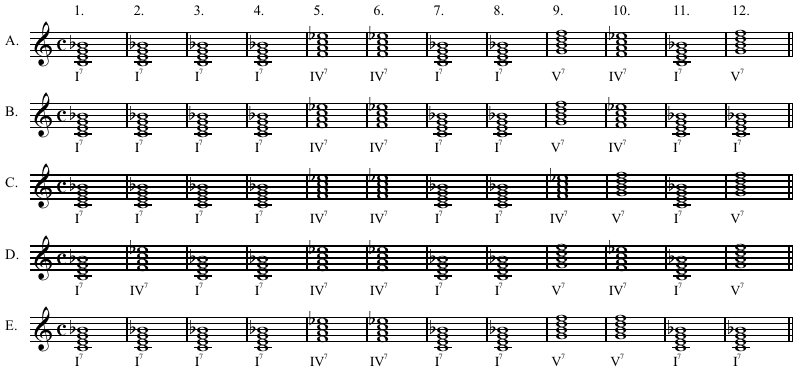Twelve-bar blues

Thetwelve-bar blues(orblues changes) is one of the most prominentchord progressionsinpopular music.Thebluesprogression has a distinctive form inlyrics,phrase,chordstructure, andduration.In its basic form, it is predominantly based on theI,IV,andVchords of a key. Mastery of the blues andrhythm changesare "critical elements for building ajazzrepertoire ".[1]
Background
[edit]The blues originated from a combination of work songs, spirituals, and early southern country music.[2]The music was passed down through oral tradition. It was first written down byW. C. Handy,anAfrican Americancomposer and band leader. Its popularity led to the creation of "race records"and the popularity of blues singers likeBessie SmithandMa Rainey.[3]The style of music heard on race records was later called "rhythm and blues"(R & B). As the music became more popular, more people wanted to perform it. General patterns that existed in the blues were formalized, one of these being the 12-bar blues.[2]
Basic progression
[edit]The basic progression for a 12-bar blues may be represented in several ways. It is shown in its simplest form, without the common "quick change",turnarounds,or seventh chords. For variations, see the following section.
C C C C F F C C G G C C
- Functional notation – chords are represented byTto indicate thetonic,Sfor thesubdominant,andDfor thedominant:[5]
T T T T S S T T D D T T
- Roman numeral notation–Irepresents the tonic,IVthe sub-dominant, andVthe dominant:[5]
I I I I IV IV I I V V I I
Variations
[edit]Shuffle blues
[edit]In the original form, the dominant chord continued through the tenth bar; later on, the V–IV–I–I "shuffle blues" pattern became standard in the third set of four bars:[6]
I I I I IV IV I I V IV I I
Quick to four
[edit]
The common quick-change, quick to four, or quick four variation uses the subdominant or IV chord in the second bar.[7]
I IV I I IV IV I I V V I I
Seventh chords
[edit]Seventh chords are a type of chord that includes the 7th scale degree (that is, the 7th note of the scale). There are different types of 7th chords such as major 7ths, dominant 7ths, minor 7ths, half diminished 7ths, and fully diminished 7ths.[8]These chords are similar with slight changes, but are all centered around the same key center. Dominant 7th chords are generally used throughout a blues progression. The addition of dominant 7th chords as well as the inclusion of other types of 7th chords (i.e. minor and diminished 7ths) are often used just before a change, and more changes can be added. A more complicated example might look like this, where "7" indicates a seventh chord:
I IV I I7 IV IV7 I I7 V IV I V7
Bebop blues
[edit]This progression is similar toCharlie Parker's "Now's the Time","Billie's Bounce",Sonny Rollins's "Tenor Madness",and many otherboptunes.[9]Peter Spitzer describes it as "a bopsoloist'scliche toarpeggiatethis chord [A7♭9(V/ii= VI7♭9)] from the3up to the♭9."[9]
I7 IV7 I7 V7I7 IV7 ♯IVo7 I7 V/ii♭9 ii7 V7 I7V/ii♭9 ii7V7
Minor blues
[edit]There are also minor twelve-bar blues, such asJohn Coltrane's "Equinox"and"Mr. P.C.".[10]The chord on the fifthscale degreemay be major (V7) or minor (v7).[10]Major and minor can also be mixed together, a signature characteristic of the music ofCharles Brown.[11]
i7 i7 i7 i7 iv7 iv7 i7 i7 ♭VI7 V7 i7 i7
Other variations
[edit]"W. C. Handycodified this blues form to help musicians communicate chord changes. "[12]Many variations are possible. The length of sections may be varied to createeight-bar bluesorsixteen-bar blues.

Melodic line
[edit]As the chords of a 12-bar blues follow a form, so does the melodic line. The melodic line might just be the melody of the piece or it might also include lyrics. The melody and lyrics frequently follow an AA'B form, meaning one phrase is played then repeated (perhaps with a slight alteration), then something new is played.[14]This pattern is frequently used in the blues and in musical genres that have their roots in the blues.[15]
See also
[edit]References
[edit]- ^Thomas 2002,p. 85.
- ^abGridley 2000.
- ^"What Is the Blues?".Pbs.org.2003.RetrievedOctober 12,2021.
- ^Benward & Saker 2003,p. 186.
- ^abKernfeld 2007.
- ^Gerow & Tanner 1984,p. 37: cited in Baker 2004: "This alteration [V–IV–I rather than V–V–I] is now considered standard."
- ^McCumber 2006,p. 25.
- ^Mount, Andre."Seventh Chords".Milnepublishingonline.RetrievedNovember 29,2021.
- ^abSpitzer 2001,p. 62.
- ^abSpitzer 2001,p. 63.
- ^di Perna 1991,pp. 180, 80: "Brown alternates between an Fmin7 and a B7. Minor to major, just like the man says."
- ^Jackson 2002,p. 18.
- ^Benward & Saker 2003.
- ^Spitzer 2001.
- ^Farrant, Dan (9 September 2020)."12-Bar Blues Form: A Complete Guide".Hellomusictheory.com.RetrievedOctober 12,2021.
Sources
[edit]- Benward, Bruce; Saker, Marilyn Nadine (2003).Music: In Theory and Practice, Vol. I(7th ed.).McGraw-Hill.ISBN978-0-07-294262-0.
- Covach, John (2005). "Form in Rock Music: A Primer". In Stein, Deborah (ed.).Engaging Music: Essays in Music Analysis.Oxford University Press.ISBN0-19-517010-5.
- di Perna, Alan (1991). "Jazzin' the Blues with Charles Brown".Musician, issues 147–152.Amordian Press.
- Gerow, Maurice;Tanner, Paul(1984).A Study of Jazz.William C. Brown.ISBN978-0-07-294262-0.
Cited in Baker, Robert M. (2005)
- Gridley, Mark C. (2000).Jazz Styles: Jazz Classics Compact Disc.Sony Music.ISBN0-13-012693-4.
- Jackson, Fruteland(2002).Beginning Delta Blues Guitar.Alfred Publishing.ISBN978-0-7390-3006-6.
- Kernfeld, Barry, ed. (2007). "Blues progression".The New Grove Dictionary of Jazz.Vol. 2.Oxford University Press.
- McCumber, Dennis (2006).The Total Blues Guitarist.Alfred Publishing.ISBN9780739038499.
- Middleton, Richard(1990).Studying Popular Music.Open University Press.ISBN0-335-15275-9.
- Spitzer, Peter (2001).Jazz Theory Handbook.Mel Bay.ISBN978-0-7866-5328-7.
- Thomas, John (2002).Voice Leading for Guitar: Moving Through the Changes.Berklee Press.ISBN0-634-01655-5.
- van der Merwe, Peter(1989).Origins of the Popular Style.Clarendon Press.ISBN0-19-316121-4.
Cited in Middleton (1990)

